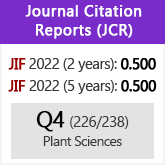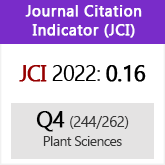Inflorescence and floral traits of the Colombian species of Tristerix (Loranthaceae) related to hummingbird pollination
DOI:
https://doi.org/10.3989/ajbm.2474Keywords:
Explosive anthesis, fenestrate anthesis, flower development, flower morphoanatomy, inflorescence development, ornithophily syndrome, páramo mistletoes, SantalalesAbstract
Floral diversification in Loranthaceae reaches its highest peak in the Andes. The flowers of the exclusively Andean genus Tristerix exhibit tubular and vividly coloured flowers pollinated by hummingbirds. We studied inflorescence and flower morphoanatomy of the two Colombian species, T. longebracteatus and the highly endangered T. secundus. Both species have terminal racemes with up to 26 ebracteolate flowers, of which the proximal one opens and sets fruits first. The slightly irregular calyx initiation is followed by the simultaneous initiation of petals and the successive initiation of stamens. Anthesis is fenestrate, explosive, and triggered by the tension of the style against the abaxial petals, a mode so far not reported in Loranthaceae. Anthetic petals spread symmetrically in T. longebracteatus and asymmetrically in T. secundus. Nectar is produced by a supraovarial disk and by the petal mesophyll. Floral lifespan lasts up to 20 days. The hummingbirds Eriocnemis vestita and Pterophanes cyanopterus are the likely pollinators of T. secundus. Morphological traits are inconclusive to support one of the two competing sister group relationships that involve Tristerix, as the lack of cataphylls in renewal shoots links Ligaria and Tristerix, whereas the terminal inflorescences support its relationship with Desmaria and Tupeia.
Downloads
References
Aizen M.A. 2005. Breeding system of Tristerix corymbosus (Loranthaceae), a winter-flowering mistletoe from the southern Andes. Australian Journal of Botany 53: 357–361. https://doi.org/10.1071/BT04088
Aluri R.J.S. & Subba Redi S. 1995. Explosive pollen release and pollination in flowering plants. Proceedings of the Indian National Science Academy B61: 323–332.
Amico G.C., Vidal-Russell R. & Nickrent D.L. 2007. Phylogenetic relationships and ecological speciation in the mistletoe Tristerix (Loranthaceae): The influence of pollinators, dispersers, and hosts. American Journal of Botany 94: 558–567. https://doi.org/10.3732/ajb.94.4.558 PMid:21636426
Barlow B.A. & Wiens D. 1973. The classification of the generic segregates of Phrygilanthus (= Notanthera) of the Loranthaceae. Brittonia 25: 26–39. https://doi.org/10.2307/2805488
Bernhard P., Knox R.B. & Calder D.M. 1980. Floral biology and self-incompatibility in some Australian mistletoes of the genus Amyema (Loranthaceae). Australian Journal of Botany 28: 437–451. https://doi.org/10.1071/BT9800437
Bhatnagar S.P. & Chandra S. 1968. Endosperm in Psittacanthus. Current Science 24: 704–706.
Bhatnagar S.P. & Johri B.M. 1983. Embryology of the Loranthaceae. In Calder M. & Bernhardt P. (eds.), The biology of mistletoes: 47–67. Academic Press, Sydney. PMCid:PMC2417593
Blakely W.F. 1922. The Loranthaceae of Australia. Proceedings of the Linnean Society of New South Wales 47: 1–25.
Dixit S.N. 1958. Morphological and embryological studies in the family Loranthaceae IV. Amyema van Tiegh. Phytomorphology 8: 346–364.
Engler A & Krause K. 1935. Loranthaceae. In Engler A. & Prantl K. (eds.), Die Natürlichen Pflanzenfamilien ed. 2: 98–203. Engelmann, Leipzig.
Evans M.S. 1895. The fertilisation of Loranthus kraussianus and L. dregei. Nature 51: 235–236. https://doi.org/10.1038/051235a0
Feehan J. 1985. Explosive flower opening in ornithophily: a study of pollination mechanisms in some Central African Loranthaceae. Botanical Journal of the Linnean Society 90: 129–144. https://doi.org/10.1111/j.1095-8339.1985.tb02205.x
Galetto L., Bernardello L. & Juliani H.R. 1990. Acerca del nectario, néctar y visitantes florales en Ligaria cuneifolia (Loranthaceae). Darwiniana 30: 155–161. http://www.jstor.org/stable/23222525
Graves G.R. 1982. Pollination of a Tristerix mistletoe (Loranthaceae) by Diglossa (Aves, Thraupidae). Biotropica 14: 316–317. https://doi.org/10.2307/2388094
Heide-Jørgensen H.S. 2008. Parasitic flowering plants. Brill, Leiden, Netherlands. https://doi.org/10.1163/ej.9789004167506.i-438 PMCid:PMC2605821
Johow F. 1900. Zur Bestäubungsbiologie chilenischer Blüthen. I. Verhandlungen des Deutschen wissenschäflichen vereins zu Santiago de Chile 4: 1–22.
Johri B.M., Agrawal J.S. & Garg S. 1957. Morphological and embryological studies in the family Loranthaceae. I. Helicanthes elastica (Desr.) Dans. Phytomorphology 7: 336–354.
Kirkup D. 1998. Pollination mechanisms in African Loranthaceae. In Polhill R & Wiens D. (eds.), Mistletoes of Africa: 37–60. Royal Botanic Gardens, Kew.
Kuijt J. 1985. Morphology, biology, and systematic relationships of Desmaria (Loranthaceae). Plant Systematics and Evolution 151: 121–130. https://doi.org/10.1007/BF02418024
Kuijt J. 1988. Revision of Tristerix (Loranthaceae). Systematic Botany Monographs 19: 1–61. https://doi.org/10.2307/25027693
Kuijt J. 2015. Santalales. In Kuijt J. & Hansen B. (eds.), The families and genera of vascular plants 12: 1–189. Springer, Cham.
Ladley J.J., Kelly D. & Robertson A.W. 1997. Explosive flowering, nectar production, breeding systems, and pollinators of New Zealand mistletoes (Loranthaceae). New Zealand Journal of Botany 35: 345–360. https://doi.org/10.1080/0028825X.1997.10410160
Maheshwari P., Johri B.M. & Dixit S.N. 1957. The floral morphology and embryology of the Loranthoideae (Loranthaceae). Journal of the Madras University 27: 121–136.
Mauseth J.D., Montenegro G. & Walckowiak A.M. 1985. Host infection and flower formation by the parasite Tristerix aphyllus (Loranthaceae). Canadian Journal of Botany 63: 567–581. https://doi.org/10.1139/b85-072
Nickrent D.L., Malécot V., Vidal-Russell R. & Der J.P. 2010. A revised classification of Santalales. Taxon 59: 538–558.
Reiche K. 1904. Bau und Leben der chilenischen Loranthacee Phrygilanthus aphyllus. Flora 93: 271–297.
Smart C. 1952. The life history of Tupeia Cham. et Schl. (Loranthaceae). Transactions of the Royal Society of New Zealand 79: 459–466.
Su H-J., Hu J-M., Anderson F.E., Der J.P. & Nickrent D.L. 2015. Phylogenetic relationships of Santalales with insights into the origins of holoparasitic Balanophoraceae. Taxon 64: 491–506. https://doi.org/10.12705/643.2
Suaza-Gaviria V, Pabón-Mora N.L. & González F. 2016. Development and morphology of flowers in Loranthaceae. International Journal of Plant Sciences 177: 559–578. https://doi.org/10.1086/687280
Suaza-Gaviria V., González F. & Pabón-Mora N.L. 2017. Comparative inflorescence development in selected Santalaes. American Journal of Botany 104: 24–38. https://doi.org/10.3732/ajb.1600253 PMid:28057689
Tadey M. & Aizen M.A. 2001. Why do flowers of a hummingbird-pollinated mistletoe face down? Functional Ecology 15: 782–790. https://doi.org/10.1046/j.0269-8463.2001.00580.x
Van Tieghem P. 1895. Sur la structure et les affinités des Tupeia, Ginalloa, Phoradendron et Dendrophthora, de la famille des Loranthacees. Bulletin de la Société Botanique de France 42: 643–652. https://doi.org/10.1080/00378941.1895.10830650
Vidal-Russell R. & Nickrent D.L. 2008. Evolutionary relationships in the showy mistletoe family (Loranthaceae). American Journal of Botany 95: 1015–1029. https://doi.org/10.3732/ajb.0800085 PMid:21632422
Werth E. 1915. Kurzer Überblick über die Gesamtfrage der Ornithophilie. Botanische Jahrbücher für Systematik, Pflanzengeschichte und Pflanzengeographie 53: 314–378.
Wilson C.A. & Calvin C.L. 2006. Character divergences and convergences in canopy-dwelling Loranthaceae. Botanical Journal of the Linnean Society 150: 101–113. https://doi.org/10.1111/j.1095-8339.2006.00488.x
Yumoto T., Itino T. & Nagamasu H. 1997. Pollination of hemiparasites (Loranthaceae) by the spider hunters (Nectariniidae) in the canopy of a Bornean tropical rain forest. Selbyana 18: 51–60. http://www.jstor.org/stable/41759942
Published
How to Cite
Issue
Section
License
Copyright (c) 2017 Consejo Superior de Investigaciones Científicas (CSIC)

This work is licensed under a Creative Commons Attribution 4.0 International License.
© CSIC. Manuscripts published in both the printed and online versions of this Journal are the property of Consejo Superior de Investigaciones Científicas, and quoting this source is a requirement for any partial or full reproduction.All contents of this electronic edition, except where otherwise noted, are distributed under a “Creative Commons Attribution 4.0 International” (CC BY 4.0) License. You may read here the basic information and the legal text of the license. The indication of the CC BY 4.0 License must be expressly stated in this way when necessary.
Self-archiving in repositories, personal webpages or similar, of any version other than the published by the Editor, is not allowed.

















